Related Research Articles
Isolationism is a political philosophy advocating a national foreign policy that opposes involvement in the political affairs, and especially the wars, of other countries. Thus, isolationism fundamentally advocates neutrality and opposes entanglement in military alliances and mutual defense pacts. In its purest form, isolationism opposes all commitments to foreign countries including treaties and trade agreements. This distinguishes isolationism from non-interventionism, which also advocates military neutrality but does not necessarily oppose international commitments and treaties in general.
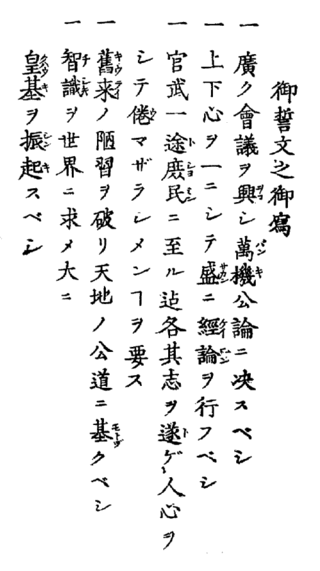
The Charter Oath was promulgated on 6 April 1868 in Kyoto Imperial Palace. The Oath outlined the main aims and the course of action to be followed during Emperor Meiji's reign, setting the legal stage for Japan's modernization. This also set up a process of urbanization as people of all classes were free to move jobs so people went to the city for better work. It remained influential, if less for governing than inspiring, throughout the Meiji era and into the twentieth century, and can be considered the first constitution of modern Japan.

Sonnō jōi was a yojijukugo phrase used as the rallying cry and slogan of a political movement in Japan in the 1850s and 1860s during the Bakumatsu period. Based on Neo-Confucianism and Japanese nativism, the movement sought to overthrow the Tokugawa shogunate and restore the power of the Emperor of Japan.
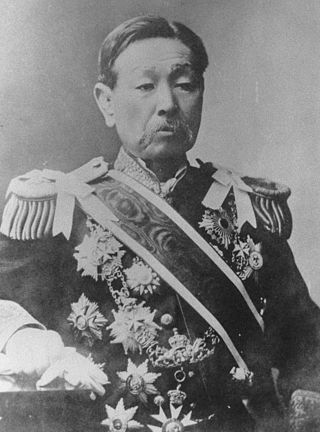
Marquess Inoue Kaoru was a Japanese politician and a prominent member of the Meiji oligarchy during the Meiji period of the Empire of Japan. As one of the senior statesmen (Genrō) in Japan during that period, he had a tremendous influence on the selection of the nation's leaders and formation of its policies.

Prince Komatsu Akihito was a Japanese career officer in the Imperial Japanese Army, who was a member of the Fushimi-no-miya, one of the shinnōke branches of the Imperial Family of Japan, which were eligible to succeed to the Chrysanthemum Throne.

CountHasegawa Yoshimichi was a field marshal in the Imperial Japanese Army and Japanese Governor General of Korea from 1916 to 1919. His Japanese decorations included Order of the Golden Kite and Order of the Chrysanthemum.

Viscount Kawamura Kageaki was a field marshal in the Imperial Japanese Army.

CountSoejima Taneomi was a diplomat and statesman during early Meiji period Japan.
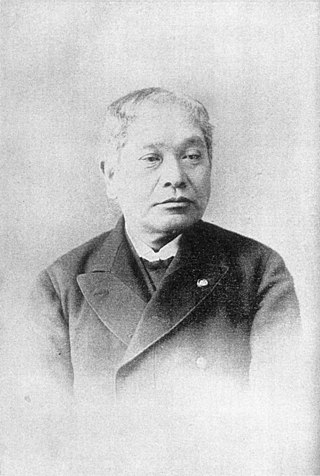
Ōki Takatō, was a Japanese statesman during the early Meiji period. He was Governor of Tokyo in 1868 and a member of the Japanese Privy Council in 1889.

Count Gotō Shōjirō was a Japanese samurai and politician during the Bakumatsu and early Meiji period of Japanese history. He was a leader of Freedom and People's Rights Movement which would evolve into a political party.
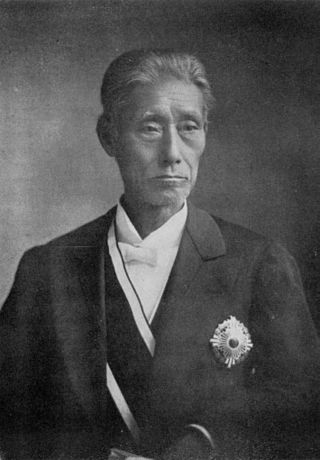
Viscount Fukuoka Takachika was a Japanese statesman of the Meiji period.

Viscount Yuri Kimimasa was a statesman in Meiji period Japan. During the Meiji Restoration he used the alias Mitsuoka Hachirō
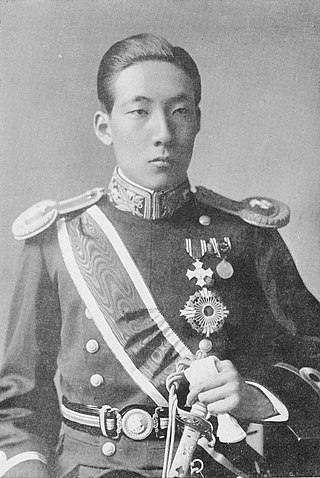
Prince Kachō Hirotada of Japan, was a member of a collateral branch of the Japanese imperial family.
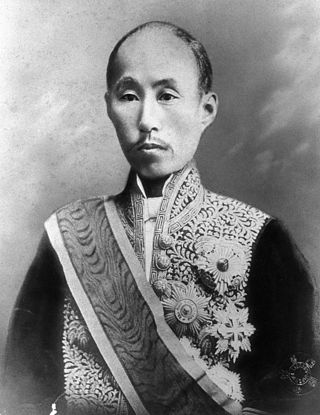
Prince Sanjō Sanetomi was a Japanese Imperial court noble and statesman at the time of the Meiji Restoration. He held many high-ranking offices in the Meiji government.
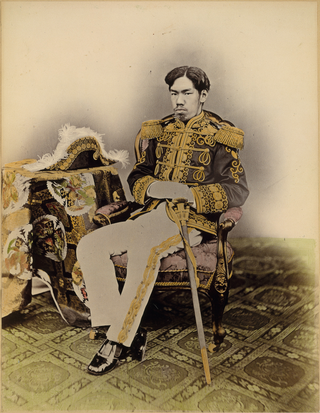
The Meiji Restoration, referred to at the time as the Honorable Restoration, and also known as the Meiji Renovation, Revolution, Regeneration, Reform, or Renewal, was a political event that restored practical imperial rule to Japan in 1868 under Emperor Meiji. Although there were ruling emperors before the Meiji Restoration, the events restored practical abilities and consolidated the political system under the Emperor of Japan. The goals of the restored government were expressed by the new emperor in the Charter Oath.
Marius Berthus Jansen was an American academic, historian, and Emeritus Professor of Japanese History at Princeton University.
Dorothy Ko is a Professor of History and Women's Studies at the Barnard College of Columbia University. She is a historian of early modern China, known for her multi-disciplinary and multi-dimensional research. As a historian of early modern China, she has endeavored to engage with the field of modern China studies; as a China scholar, she has always positioned herself within the study of women and gender and applied feminist approaches in her work; as a historian, she has ventured across disciplinary boundaries, into fields that include literature, visual and material culture, science and technology, as well as studies of fashion, the body and sexuality.

Count Hijikata Hisamoto was a Japanese politician and cabinet minister of the Meiji period.
The bibliography covers the main scholarly books, and a few articles, dealing with the History of Japan
Joan R. Piggott is an American historian specializing in East Asian studies.
References
- ↑ "Gilbert Friedell Rozman". Office of the Dean of the Faculty, Princeton University. 2013. Retrieved 14 April 2019.
- ↑ "Dr. Gilbert Rozman" (PDF). United States-China Economic and Security Review Commission. Retrieved 14 April 2019.
- ↑ "Gilbert Rozman". Department of Sociology, Princeton University. Retrieved 14 April 2019.
- ↑ Rozman, Gilbert (1999). "China's quest for great power identity". Orbis. 43 (3): 383–402. doi:10.1016/S0030-4387(99)80078-7.
- ↑ Rozman, Gilbert (March 2012). "East Asian Regionalism and Sinocentrism". Japanese Journal of Political Science. 13 (1): 143–153. doi:10.1017/S1468109911000338.
- ↑ Falkus, Malcolm (May 1977). "Individual Towns and Regions - Gilbert Rozman, Urban Networks in Russia 1750–1800 and Premodern Periodization. Princeton and Guildford: Princeton University Press, 1976. 337 pp. Tables. Figs. Bibliography. $16.50. £9·40. - James H. Bater, St Petersburg: Industrialization and Change [Studies in Urban History 4]. London: Edward Arnold, 1976. xxiii + 469 pp. Plates. Tables. Figs. £14·95". Urban History. 4: 92–94. doi:10.1017/S0963926800002674.
- ↑ Schwartz, Benjamin I. (1 June 1975). "Gilbert Rozman. Urban Networks in Ch'ing China and Tokugawa Japan. Princeton: Princeton University Press. 1973. Pp. xiv, 355. $16.50". The American Historical Review. 80 (3): 705–706. doi:10.1086/ahr/80.3.705-a.
- ↑ Fairbank, J. K. (1 October 1982). "Gilbert Rozman, editor. The Modernization of China. New York: Free Press and Collier Macmillan, London. Under the auspices of the Center of International Studies, Princeton University. 1981. Pp. xv, 551. $22.50". The American Historical Review. 87 (4): 1142–1143. doi:10.1086/ahr/87.4.1142.
- ↑ Howes, John F. (1 April 1988). "Japan in Transition: from Tokugawa to Meiji, edited by Marius B. Jansen and Gilbert Rozman". Canadian Journal of History. 23 (1): 134–135. doi:10.3138/cjh.23.1.134.
- ↑ Johnson, Linda L. (1 February 1987). "Japan in Transition from Tokugawa to Meiji. Edited by Marius B. Jansen and Gilbert Rozman. Princeton: Princeton University Press, 1986. xii, 485 pp. Figures, Maps, Tables, Notes, About the Contributors, Index. $47.50". The Journal of Asian Studies. 46 (1): 153–154. doi: 10.2307/2056694 . JSTOR 2056694.
- ↑ Henderson, John (1 January 1993). "Review of: Gilbert Rozman, ed., "The East Asian Region: Confucian Heritage and Its Modern Adaptation" (Book Review)". Journal of the Economic and Social History of the Orient. 36: 368. doi:10.2307/3632294. JSTOR 3632294.
- ↑ Young Chul Cho (July 2013). "East Asian National Identities: Common Roots and Chinese Exceptionalism, edited by Gilbert Rozman. Washington: Woodrow Wilson Center Press; Stanford: Stanford University Press, 2012. xiv + 283 pp. US$50.00 (hardcover)". The China Journal. 70 (70): 274–277. doi:10.1086/671320.